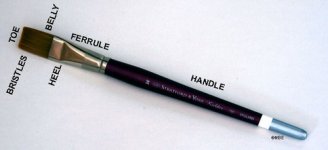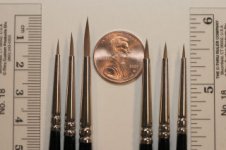As chips can often be much deeper than just a layer or two of paint, Idon't bother with a primer, but rather build up the layer using the same colour - thin dab, wait until dry, then another thin dab etc. until the paint on the chip is flush with the surrounding paintwork.
Looks like you're not going to get one answer to any of your questions.
Hi Simon,



Based on your comment above, I think it is time to take stock of what I have learned in this thread before proceeding to my next question. Now, let me see....
My first question was concerned with knowing why certain brands of paint seemed superior to all others. What I learned was there are two types of paint: oil based paints and acrylics. If one wants a glossy finish, oil based paints seem to be the best choice, unless....
you want to use acrylics. If you want to use acrylics, you may apply some "wonder mist" and cause the colors to shine. If you prefer a matte finish, then the use of acrylics seems to be the superior choice. However, if you prefer oil based paint, but you want a matte finish, you may "dull down" the glossy finish by adding wax to the glossy paint. Of course, if you live in Canada, you dull down the paint by adding baby powder to it. Hmmmmm. I am glad I am only asking basic questions!
Then there is the matter of clean up. If I understand what I have been told, oil based paints stink and cleaning up after using them is a pain, whereas, the use of acrylics results in a stink free environment and the clean up only requires some soap and water. These are excellent points in response to a question I did not ask. However, I will file this information for future use.
I then asked about the brushes that are necessary in order to meet most needs the toy soldier painter might encounter. From the generous responses I received to my question, I learned that there are expensive brushes and there are cheap brushes. Some expensive brushes are no good and some cheap ones are superior to most expensive ones. However, no one commented on how to tell the difference. Some painters indicated they owned many brushes. I suppose that is because they cannot tell the difference either. Therefore, I have concluded it makes no difference what kind of brushes one uses because you can make an equal mess with whichever brush you desire using at the time.
I also learned Simon frequently uses a #2 Flat, but he has no earthly idea why. Is this a common condition witnessed among painters? Wait! Please don't answer that! The answer might be more than I can handle!
Finally, I asked about the use of primer when touching up paint chips. It seems that you can use primer if you want to, otherwise you simply keep globbing on paint until you tire of doing so.
Is my summary above about right?
Isn't this forum wonderful for gathering much needed information?
Since I am now armed with a body of basic knowledge, I shall forge ahead with my next basic question. According to the Michigan Toy Soldier tutorial on painting metal figures,...
When starting to base coat the uniform we want to make sure that we are painting from the "inside out". In other words, we want to paint the tunic not the belt, the collar not the grenade sandbags. This allows us to fully cover all of the hard to reach areas without risk of slopping paint on items already painted.
My question:
Does the same principle of painting from the inside out also apply to correcting paint chips? For example, should paint chips on the hides of horses be corrected before paint chips on harnesses are addressed?
As you might imagine, I anxiously await your replies.

Warmest personal regards,
Pat


I thought I was asking a simple question that would generate a simple answer! Let me return to the three tentative conclusions I reached in frame #8.








